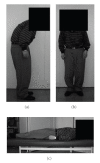Camptocormia in Parkinson's disease
- PMID: 20948888
- PMCID: PMC2951140
- DOI: 10.4061/2010/267640
Camptocormia in Parkinson's disease
Abstract
Objectives. Abnormalities of posture represent one of the main features of Parkinson's disease (PD). Among them, camptocormia has been considered as rare in PD. We investigated frequency and clinical features of camptocormia in PD patients. Methods. 153 PD patients (mean 68.5 ± 10.7 years old, duration 5.9 ± 2.4 years) outpatiently recruited. After neurologic examination, patients were rated on the Unified PD Rating Scale motor scale (UPDRS Part III), minimental state examination (MMSE). Also we evaluated patients with camptocormia by MRI. Of the 153 PD patients, 27 had camptocormia (mean age, 67.9 ± 7.9 years old; disease duration, 6.1 ± 3.9 years). For further evaluation, we recruited age- and sex-matched 27 PD patients without camptocormia (11 men and 16 women; mean age ± SD, 69.2 ± 10.1 years, duration 6.0 ± 2.7 years) These selected 54 patients completed several self-assessments. Lumbar and thoracic paraspinal muscles were studied by EMG. Results. There were no significant differences in age, duration, severity, and drug dose between patients with and without camptocormia. Analysis of NMSS subitems indicated that PD patients tended to show lower scores for sleep/fatigue, attention/memory, and miscellaneous items. Conclusions. We found significant differences concerning nonmotor signs and symptoms evaluated by FAB, PDQ-8, FSQ, VAS-F, and NMSS between patients with and without camptocormia. Our findings indicate that camptocormia is a relatively common sign in PD and that patients with camptocormia scores on the PDQ-8 compared with PD patients without camptocormia. This suggests that improvements in camptocormia of PD patients may improve their QOL.
Figures
References
-
- Ashour R, Jankovic J. Joint and skeletal deformities in Parkinson’s disease, multiple system atrophy, and progressive supranuclear palsy. Movement Disorders. 2006;21(11):1856–1863. - PubMed
-
- Parkinson J. An Essay of the Shaking Palsy. London, UK: Whittingham and Rowland; 1817.
-
- Brodie BC. Pathological and surgical observations of the disease of the joints. In: Hurst R, Orme B, editors. Longman. London, UK: 1818;1822. p. 376.
-
- Souques A, Rosanoff-Saloff M. La camptocormie; incurvation du tronc, consecutive aux traumatismes du dos et des lombes; considérations morphologiques. Revista de Neurologia. 1914;28:937–939.
LinkOut - more resources
Full Text Sources
Other Literature Sources


